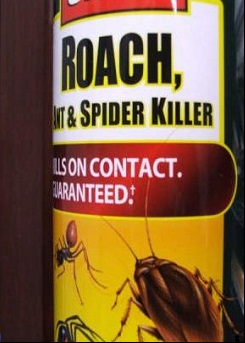What Are the “Other Ingredients” in a Pesticide Product?
By Chris Williams on December 5, 2013.

Question
How come when I look at a pesticide container, even something like insect repellent, it lists the DEET that I know is in there at 25%, but then it also has a line that says “Other Ingredients…..75%.” How do I know what those “other” ingredients are that I’m spraying on my kid, and how come the manufacturer doesn’t have to tell me?
Answer
This is a question that frequently comes up among pest control professionals, too. The DEET in your insect repellent is called an “active ingredient” because it is the pesticide that does the job of repelling the pest. The “other ingredients” don’t have to be identified (and there is some debate about this) because they are inert. They have no pesticidal action of their own. The other ingredients in a pesticide product are sometimes called “inerts,” or “additives,” or “adjuvants.”
Inert ingredients are added to the pure pesticide as helpers. They help the pesticide stick to a surface, or spread over a surface, prevent foaming, allow easier mixing, control drift, or increase shelf life. Some pesticides wouldn’t work at all without their inert ingredients.
Why Won’t They Tell Us?
Pesticide manufacturers traditionally have not identified the inerts in their products, claiming that the information is protected as a trade secret or is confidential business information. But they must make that information available to EPA which approves all inerts that are allowed in products. EPA’s approved list of inerts is over 300 pages long and is available to the public. The list ranges from cornmeal, to sunflower oil, to sulfuric acid and formaldehyde,to solvents like kerosene.The odor that we blame on the pesticide is usually from an inert solvent in the product instead. Some of the same inerts used in pesticides are used in other consumer products like soaps, perfumes, and cleaners.
EPA considers all inert ingredients to have some level of toxicity and ranks them from low to high. The toxicity of a pesticide product depends on the combined toxicities of both the active ingredient and the other ingredients.Only inert ingredients that EPA says present a hazard to human health or the environment, such as xylene, are required to be identified by name on the pesticide label.At least manufacturers do have to list the percentage of the product that is made up of other ingredients, which is often more than 90% of the total volume or weight of the product.
After being challenged in court on its inerts policy, EPA announced in 2010 that it was finally going to require pesticide manufacturers to disclose the “other ingredients” in their products…but we haven’t seen it yet. There are ways to find out the inert ingredients in a pesticide product but it’s not easy. It’s up to the manufacturer whether it wants to give you that information. Or, if you have a lot of free time, you can submit a Freedom of Information Act request to EPA to disclose the “other ingredients” in a particular product.
Learn the do not’s of using pesticides here.